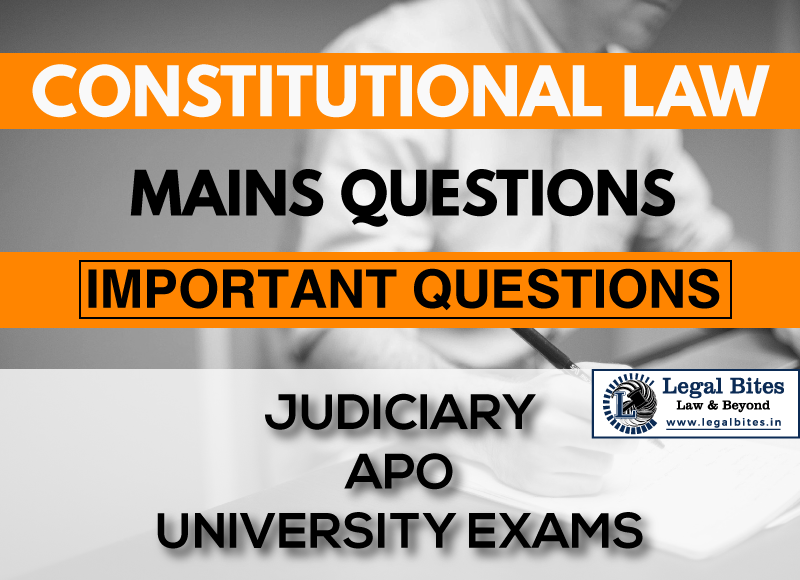How did the right to property in India compare with its counterpart (right to property) in English law before the right to property in India was raised to the level of a fundamental right on and from the 26th January 1950? What different changes has this right in India been undergoing since the 26th of January, 1950? What is its position today and how does it compare with the right to property in England today.
Question: How did the right to property in India compare with its counterpart (right to property) in English law before the right to property in India was raised to the level of a fundamental right on and from the 26th January 1950? What different changes has this right in India been undergoing since the 26th of January, 1950?… Read More »

Question: How did the right to property in India compare with its counterpart (right to property) in English law before the right to property in India was raised to the level of a fundamental right on and from the 26th January 1950? What different changes has this right in India been undergoing since the 26th of January, 1950? What is its position today and how does it compare with the right to property in England today. [BJS 1977] Find the answer to the mains question only on Legal Bites....
Question: How did the right to property in India compare with its counterpart (right to property) in English law before the right to property in India was raised to the level of a fundamental right on and from the 26th January 1950? What different changes has this right in India been undergoing since the 26th of January, 1950? What is its position today and how does it compare with the right to property in England today. [BJS 1977]
Find the answer to the mains question only on Legal Bites. [How did the right to property in India compare with its counterpart (right to property) in English law before the right to property in India was raised to the level of a fundamental right on and from the 26th January 1950? What different changes has this right in India been undergoing since the 26th of January, 1950? What is its position today and how does it compare with the right to property in England today.]
Answer
Before the independence, the right to possess and dispose of properties was provided under the infamous Government of India Act of 1935. The Act 1935 was the last of the constitutional changes enacted by the British Parliament to respond to the increasing demands for greater autonomy since the late 19th century. Section 299 of the 1935 Act assured protection of such rights to all individuals irrespective of whether they were zamindars or peasants. This safeguarded the people and ensured that there is no exploitation or abuse of their property without payment of adequate compensation. Also, the Act allowed the use of private property by the government only and for public purposes.
Since the Constitution of India came into force in the 1950s, the right to property was given fundamental status. Basically, two articles Article 31 and Article 19(1) (f) ensures that any person’s right against his property remains protected.
Article 31 clauses (1) reads as No person shall be deprived of his property save by authority of law. It gives protection to persons against the government or State’s arbitrary action to seize private property for public use and private use. That means a person has the right to move to SC in case of violation of this right. Similarly, in English Law, this power was limited by imposing three restrictions:
- there must be a law authorizing the taking of property
- the property must be taken for a public purpose
- Just compensation should be paid.
In India clause Article 31(1) provided for the first restriction and clause (2) provided that no property shall be compulsorily acquired or requisitioned save for a public purpose and save by authority of a law which provides for acquisition of the property for an amount which shall be fixed by such law, and no such law is called in question in any court on the ground that the amount so fixed is not adequate for the other two restrictions.
Moreover, Article 19(1) (f) provides the freedom to citizens to acquire, hold, and dispose of the property within the territory of India. However, but by the Constitutional 44th Amendment act 1978, these two above-mentioned articles were deleted and a new chapter IV was added in Part XII, containing only one Article 300A.
The legal status of the Right to Property was changed from the fundamental right to the constitutional right. As a result, people were not allowed to approach Supreme Court directly u/A 32 of the constitution for violation of the Right to Property although they still could invoke jurisdiction at high court u/A 226 of the Constitution. In Jilubhai Nanbhai Khachar v. State of Gujarat [AIR 1995 SC 142], it was held that the Right to property u/A 300A is not a basic structure of the Constitution. It is only a constitutional right.
Important Mains Questions Series for Judiciary, APO & University Exams
- Constitutional Law Mains Questions Series Part-I
- Constitutional Law Mains Questions Series Part-I
- Constitutional Law Mains Questions Series Part-II
- Constitutional Law Mains Questions Series Part-IV
- Constitutional Law Mains Questions Series Part-V
- Constitutional Law Mains Questions Series Part-VI
- Constitutional Law Mains Questions Series Part-VII
- Constitutional Law Mains Questions Series Part-VIII
- Constitutional Law Mains Questions Series Part-IX
- Constitutional Law Mains Questions Series Part-X
Admin Legal Bites
Legal Bites Study Materials correspond to what is taught in law schools and what is tested in competitive exams. It pledges to offer a competitive advantage, prepare for tests, and save a lot of money.
